Use of a mobile app to improve the quality of university teaching
A neuromarketing study
Abstract
Universities belonging to the European Higher Education Area -EHEA- need procedures to assess the quality of their titles. In this sense, much has been discussed about the most adequate methods to measure the satisfaction of students, as well as about how useful this variable is in reality. Taking into account the increasing demand for mobile learning applications -the so-called m-learning-, a new app to assess the quality of teaching was tested, employing neuroscientific methods to find out the emotions experienced by 22 students of the degree in Advertising and Public Relations from Complutense University. Consequently, the employed set of tecniques included registering the travel of the gaze (eye tracking), the facial expressions and the dermoelectric response of the skin. The results reflect a huge acceptance of the app. When screenshots were showed, the students payed attention to the most important areas, regardless of their genre or the academic year they were in. In addition, they conceded high ratings in the questionnaire, something that evidences how inclined they are towards this kind of tools.
Downloads
References
Adhami, M. (2013). Using neuromarketing to discover how we really feel about apps. International Journal of Mobile Marketing, 8(1), pp. 95-103. Recuperado de https://www.warc.com/content/article/ijmm/using_neuromarketing_to_discover_how_we_really_feel_about_apps/100341
Bell, L., Vogt, J., Willemse, C., Routledge, T., Butler, L. T. & Sakaki, M. (2018). Beyond self-report: A review of physiological and neuroscientific methods to investigate consumer behavior. Frontiers in Psychology, 9, pp. 1-16. doi: 10.3389/fpsyg.2018.01655
Bomhold, C. R. (2013). Educational use of smart phone technology: A survey of mobile phone application use by undergraduate university students. Program: Electronic Library and Information Systems, 47(4), pp. 424–436. doi: 10.1108/PROG-01-2013-0003
Busemeyer, J. R. & Rapoport, A. (1988). Psychological models of deferred decision making. Journal of Mathematical Psychology, 32(2), pp. 91-134. doi: 10.1016/0022-2496(88)90042-9
Cartocci, G., Cherubino, P., Rossi, D., Modica, E., Maglione, A. G., Di Flumeri, G & Babiloni, F. (2016). Gender and age related effects while watching TV advertisements: An EEG study. Computational Intelligence and Neuroscience, 2016, pp. 1-10. doi: 10.1155/2016/3795325
Clayson, D. E. (2009). Student evaluations of teaching: Are they related to what students learn? A meta-analysis and review of the literature. Journal of Marketing Education, 31(1), pp. 16-30. doi: 10.1177/0273475308324086
Cohen, M. X. (2017). Where does EEG come from and what does it mean? Trends in Neuroscience, 40(4), pp. 208-218. doi: 10.1016/j.tins.2017.02.004
Comisión Europea/EACEA/Eurydice (2018). The European Higher Education Area in 2018: Bologna process implementation report. Luxemburgo: Oficina de Publicaciones de la Unión Europea.
Couwenberg, L. E., Boksem, M. A. S., Dietvorst, R. C., Worm, L., Verbeke, W. J. M. I. & Smidts, A. (2017). Neural responses to functional and experiential ad appeals: Explaining ad effectiveness. International Journal of Research in Marketing, 34(2), pp. 355-366. doi: 10.1016/j.ijresmar.2016.10.005
Crompton, H. (2013). A historical overview of m-learning: Toward learner-centered education. En Z. L. Berge, ZL y L. Y. Muilenburg (Eds.), Handbook of Mobile Learning (pp. 3-14). Nueva York: Routledge.
Cuesta, U., Martínez-Martínez, L. & Cuesta, V. (2017). Neuromarketing olfativo: Análisis del electroencefalograma y las respuestas psicofisiológicas provocadas por diferentes olores. Madrid: Tecnos.
Cuesta, U., Martínez-Martínez, L. & Niño, J. I. (2018). A case-study in neuromarketing: Analysis of the influence of music on advertising effectiveness through eye-tracking, facial emotion and GSR. European Journal of Social Science Education and Research, 5(2), 84-92. doi: 10.2478/ejser-2018-0035
D’Apollonia, S. & Abrami, P. C. (1997). Navigating student ratings of instruction. The American Psychologist, 52(11), pp. 1198–1208. doi: 10.1037/0003-066X.52.11.1198
Fang, J., Zhao, Z., Wen, Ch. & Wang, R. (2017). Design and performance attributes driving mobile travel application engagement. International Journal of Information Management, 37(4), pp. 269-283. doi: 10.1016/j.ijinfomgt.2017.03.003
Fueyo, A. (2004). Evaluación de titulaciones, centros y profesorado en el proceso de convergencia europea: ¿De qué calidad y de qué evaluación hablamos? Revista Interuniversitaria de Formación de Profesorado, 18(3), pp. 207-219. Recuperado de https://www.aufop.com/aufop/uploaded_files/articulos/1212408107.pdf
Fugate, D. L. (2015). Neuromarketing: A layman's look at neuroscience and its potential application to marketing practice. Journal of Consumer Marketing, 24(7), pp. 385-394. doi: 10.1108/07363760710834807
García-Berro, E., Dapia, F., Amblás, G., Bugeda, G. & Roca, S. (2009). Estrategias e indicadores para la evaluación de la docencia en el marco del EEES. Revista de Investigación en Educación, 6(1), pp. 142-152. Recuperado de https://upcommons.upc.edu/bitstream/handle/2117/28115/55.pdf?sequence=1&isAllowed=y
Gaye, F. H. (2015). Neuroscience: The study of the nervous system and its functions. Daedalus, 144(1), pp. 5-9. Recuperado de https://www.amacad.org/sites/default/files/daedalus/downloads/15_Winter_Daedalus.pdf
Glover, G. H. (2011). Overview of functional magnetic resonance imaging. Neurosurgery Clinics of North America, 22(2), pp. 133-139. doi: 10.1016/j.nec.2010.11.001
Goodrich, K. (2014). The gender gap: Brain-processing differences between the sexes shape attitudes about online advertising. Journal of Advertising Research, 1(2014), pp. 32-43. doi: 10.2501/JAR-54-1-032-043
Harley, J. M. (2016). Measuring emotions: A survey of cutting edge methodologies used in computer-based learning environment research. En S. Y. Tettegah y M. Gartmeier (Eds.), Emotions, Technology, Design, and Learning (pp. 89-114). Londres y San Diego, California: Academic Press.
Hashemi, M., Azizinezhad, M., Najafi, V. & Nesari, A. J. (2011). What is mobile learning? Challenges and capabilities. Procedia: Social and Behavioral Sciences, 30(2011), pp. 2477-2481. doi: 10.1016/j.sbspro.2011.10.483
Jaén, A. & Sirignano, F. M. (2016). El aprendizaje cooperativo como estrategia didáctica para la adquisición de competencias en el EEES. Propuesta y reflexión sobre una experiencia. Hekademos: Revista Educativa Digital, 19(año IX), pp. 7-19. Recuperado de http://www.hekademos.com/hekademos/media/articulos/19/01.pdf
Javor, A., Koller, M., Lee, N., Chamberlain, L. & Ransmayr, G. (2013). Neuromarketing and consumer neuroscience: contributions to neurology. BMC Neurology, 13(1), pp. 1-12. doi: 10.1186/1471-2377-13-13
Jenaro, C., Castaño, R., Martín, M. E. & Flores, N. (2018). Rendimiento académico en educación superior y su asociación con la participación activa en la plataforma Moodle. Cultura y Educación, 34(2018), pp. 177-198. doi: 10.15581/004.34.177-198
Lee, N., Broderick, A. J. & Chamberlain, L. (2007). What is “neuromarketing”? A discussion and agenda for future research. International Journal of Psychophysiology, 63(2), pp. 199-204. doi: 10.1016/j.ijpsycho.2006.03.007
Lee, N., Chamberlain, L. & Brandes, L. (2018). Welcome to the jungle! The neuromarketing literatura through the eyes of a newcomer. European Journal of Marketing, 52(1-2), pp. 4-38. doi: 10.1108/EJM-02-2017-0122
Leite, F. P. & Ratcliff, R. (2010). Modeling reaction time and accuracy of multiple-alternative decisions. Attention, Perception, & Psychophysics, 72(1), pp. 246-273. doi: 10.3758/APP.72.1.246
Marsh, H. W. (2007). Students’ evaluations of university teaching: A multidimensional perspective. En R. P. Perry y J. C. Smart (Eds.), The scholarship of teaching and learning in Higher Education: An evidence based perspective (pp. 319–384). Nueva York: Springer.
Muñoz-Leiva, F., Hernández-Méndez, J. & Gómez-Carmona, D. (2019). Measuring advertising effectiveness in Travel 2.0 websites through eye-tracking technology. Physiology & Behavior, 200, pp. 83-95. doi: 10.1016/j.physbeh.2018.03.002
Palés-Argullós, J., Nolla-Domenjó, M., Oriol-Bosch, A. & Gual, A. (2010). Proceso de Bolonia (I): Educación orientada a competencias. Educación Médica, 13(3), pp. 1575-1813. doi: 10.33588/fem.133.564
Penny, A. R. & Coe, R. (2004). Effectiveness of consultation on student ratings feedback: A meta-analysis. Review of Educational Research, 74(2), 215-253. doi: 10.3102/00346543074002215
Plassmann, H., Ramsøy, T. Z. & Milosavljevic, M. (2012). Branding the brain: A critical review and outlook. Brand Insights from Psychological and Neurophysiological Perspectives, 22(1), pp. 18-36. doi: 10.1016/j.jcps.2011.11.010
Plassmann, H., Venkatraman, V., Huettel, S. & Yoon C. (2015). Consumer Neuroscience: Applications, Challenges, and Possible Solutions. Journal of Marketing Research, 52(4), pp. 427-435. doi: 10.1509/jmr.14.0048
Pozo, C., Bretones, B., Martos, M. J. & Alonso, E. (2011). Evaluación de la actividad docente en el Espacio Europeo de Educación Superior: un estudio comparativo de indicadores de calidad en universidades europeas. Revista Española de Pedagogía, 248(69), pp. 145-163. Recuperado de https://revistadepedagogia.org/wp-content/uploads/2011/01/248-008.pdf
Rampl, L. V., Opitz, C., Welpe, I. M. & Kenning, P. (2016). The role of emotions in decision-making on employer brands: Insights from functional magnetic resonance imaging (fMRI). Marketing Letters, 27(2), pp. 361-374. doi: 10.1007/s11002-014-9335-9
Rebollo, M. Á., García, R., Barragán, R., Buzón, O. & Ruiz, E. (2012). Tecnologías para la coeducación y la igualdad: Valoración del profesorado de una herramienta web. Educación XXI, 15(1), pp. 87-111. doi: 10.5944/educxx1.15.1.151
Reisenzein, R., Studtmann, M. & Horstmann, G. (2013). Coherence between emotion and facial expression: Evidence from laboratory experiments. Emotion Review, 5(1), pp. 16-23. doi: 10.1177/1754073912457228
Sánchez-Elvira, A., López-González, M. A. & Fernández-Sánchez, M. V. (2010). Análisis de las competencias genéricas en los nuevos títulos de grado del EEES en las universidades españolas. Red U - Revista de Docencia Universitaria, 8(1), pp. 35-73. doi: 10.4995/redu.2010.6217
Shimojo, S., Simion, C., Shimojo, E. & Scheier, C. (2003). Gaze bias both reflects and influences preference. Nature neuroscience, 6(12), pp. 1317-1322. doi: 10.1038/nn1150
Simion, C. & Shimojo, S. (2007). Interrupting the cascade: Orienting contributes to decision making even in the absence of visual stimulation. Perception & Psychophysics, 69(4), pp. 591-595. doi: 10.3758/bf03193916
Spooren, P., Brockx, B. & Mortelmans, D. (2013). On the validity of student evaluation of teaching: The state of the art. Review of Educational Research, 83(4), pp. 598-642. doi: 10.3102/0034654313496870
Stapenhurst, T. (2009). The benchmarking book: A how-to-guide to best practice for managers and practitioners. Oxford: Butterworth-Heinemann.
Vázquez-Cano, E. (2014). Mobile distance learning with smartphones and apps in Higher Education. Educational Sciences: Theory & Practice, 14(4), pp. 1505-1520. doi: 10.12738/estp.2014.4.2012
Vila-López, N. & Küster-Boluda, I. (2019). Consumers’ physiological and verbal responses towards product packages: Could these responses anticipate product choices? Physiology & Behavior, 200, pp. 166-173. doi: 10.1016/j.physbeh.2018.03.003
Wai, I. S. H., Ng, S. S. Y., Chiu, D. K. W., Ho, K. K. W. & Lo, P. (2018). Exploring undergraduate students’ usage pattern of mobile apps for education. Journal of Librarianship and Information Science, 50(1), pp. 34-47. doi: 10.1177/0961000616662699
Wright, S. L. & Jenkins-Guarnieri, S. L. (2012). Student evaluations of teaching: combining the meta-analyses and demonstrating further evidence for effective use. Assessment & Evaluation in Higher Education, 37(6), pp. 683-699. doi: 10.1080/02602938.2011.563279
Yániz, C. (2006). Planificar la enseñanza universitaria para el desarrollo de competencias. Educatio Siglo XXI: Revista de la Facultad de Educación, 24(1), pp. 17-34. Recuperado de https://revistas.um.es/educatio/article/view/151/134
Downloads
Published
How to Cite
Issue
Section
License
Los derechos de edición pertenecen a la Fundación iS+D para la Investigación Social Avanzada, entidad que edita la Revista Prisma Social, y es necesario su permiso para cualquier reproducción. En todo caso, será necesario citar la procedencia de cualquier reproducción total o parcial.
La publicación de artículos o reseñas en la Revista Prisma Social no da derecho a remuneración alguna.
Política de acceso abierto
La publicación de la Revista Prisma Social y su difusión se realiza de forma abierta a través de Internet.
La Revista Prisma Social ofrece acceso libre y abierto inmediato a su contenido de forma totalmente gratuita con el fin de hacer llegar la investigación científica a toda la sociedad y con el objetivo de crear una cultura reflexiva encaminada a la comprensión de los comportamientos sociales desde una perspectiva global.
Todos los contenidos digitales de la Revista Prisma Social son de acceso libre y gratuito y se publican bajo una licencia de Creative Commons:

está bajo una licencia de Creative Commons Reconocimiento-NoComercial-SinObraDerivada 3.0 España License.
Creado a partir de la obra en www.isdfundacion.org
Bajo esta licencia, está permitida la reproducción y difusión de los contenidos de la revista con fines educativos o de investigación, sin ánimo de lucro, siempre y cuando estos no se modifiquen, se cite la procedencia (Prisma Social, Revista de ciencias sociales), y la autoría.
Esta licencia a la que se acoge la Revista Prisma Social permite copiar, distribuir, exhibir los textos e imágenes de la revista, siempre que se cumplan las siguientes condiciones:
- Reconocimiento: Debe reconocerse y respetarse la autoría de la obra de la manera especificada por el autor y la entidad editora (Revista Prisma Social – Fundación iS+D).
- No comercial: No se puede utilizar esta obra para fines comerciales.
- No derivados: No se puede alterar, transformar o generar una obra derivada a partir de esta obra.
Se deberán establecer claramente los términos de esta licencia para cualquier uso o distribución de los documentos. Se podrá prescindir de cualquiera de estas condiciones si se obtiene el permiso expreso del autor/a.
Desde la Revista de Prisma Social se permite y se invita a los/as autores/as a ampliar la visibilidad, alcance e impacto de sus artículos publicados en la revista mediante la redifusión (auto-archivo) de los mismos en:
1. Sus espacios web personales (web, blog, redes sociales, foros científicos, etc.).
2. Archivos abiertos institucionales (archivos universitarios, Hispana, Europeana, etc.).
3. Redes sociales de naturaleza académica y científica (ResearchGate, Academia.edu, Getcited.org).
Se requiere que en dichas publicaciones se detallen todos los datos bibliográficos de la publicación.
Para más información, puede descargar y consultar las Condiciones de Publicación:

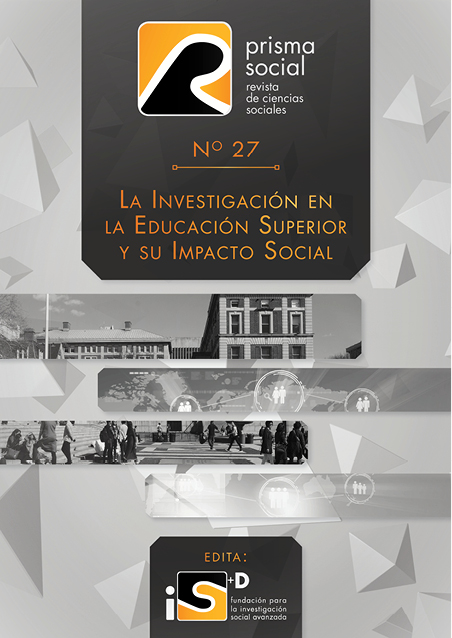




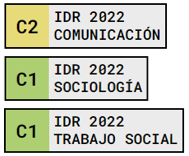

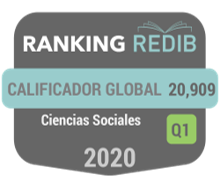
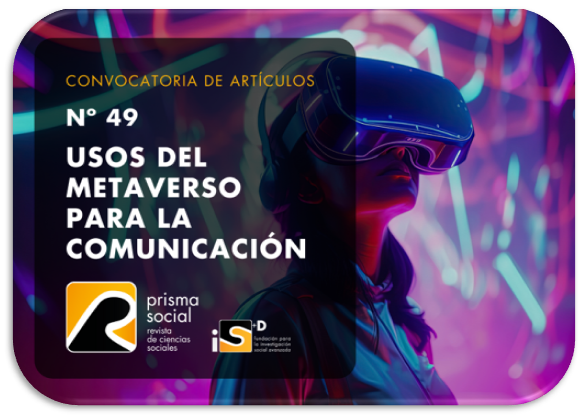
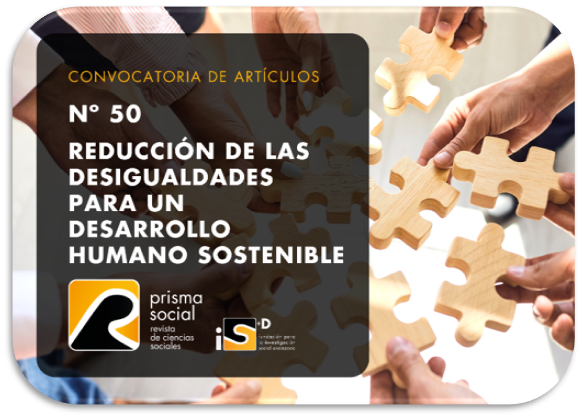








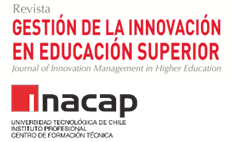



.png)




